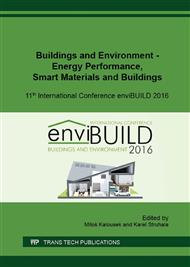[1]
Act 133/1985 Coll. with amendments, Czech National Council, Prague, (1985).
Google Scholar
[2]
Ordinance 246/2001 Coll., Ministry of the Interior of the Czech Republic, Prague, (2001).
Google Scholar
[3]
Information on: professionals/publications_and_circulars/fire_code_2007master_version/_jcr_content/par/download_4/file. res/Chap_2. pdf.
Google Scholar
[4]
Information on: http: /www. cibse. org/getmedia/194462d5-0b2f-4fda-8c67-dbd085c56c05/166_Draft-SCA-Guidance-on-Smoke-Control-in-Apartment-Buildings-doc. pdf. aspx.
Google Scholar
[5]
Information on: http: /www. gov. scot/resource/buildingstandards/2013Domestic/chunks/ch03s10. html.
Google Scholar
[6]
M. A. Grice, Fire Risk: Fire safety and its practical application, Thorogood Publishin Ltd, London, (2009).
Google Scholar
[7]
ČSN 73 0802 Fire protection of buildings – Non-industrial buildings, Czech Office for Standards, Metrology and Testing, Prague, (2009).
Google Scholar
[8]
ČSN 73 0804 Fire protection of buildings –Industrial buildings, Czech Office for Standards, Metrology and Testing, Prague, (2010).
Google Scholar
[9]
Information on: http: /www. hzscr. cz/clanek/nejtragictejsi-nasledky-maji-pozary-v-domacnostech-jak-svou-domacnost-proti-pozaru-zabezpecit. aspx.
Google Scholar
[10]
Information on: https: /sites. google. com/site/cusdfiretech/Essentials (Firefightings).
Google Scholar
[11]
Information on: http: /www. narm. org. uk.
Google Scholar
[12]
Information on: http: /domainnamesni. com/ventcontrols/smokeventilation. php.
Google Scholar
[13]
Information on: http: /www. secontrols. com/assets/uploads/White_paper_case_study_SEC_Template_V2. pdf.
Google Scholar
[14]
Z. -X. Li, Y. -D. Wang, L. Li, 3D simulation of disaster process in mine ventilation system during fire period, in Meitan Xuebao/Journal of the China Coal Society 40 (2015) pp.115-121.
Google Scholar
[15]
S. Svensson, Experimental Study of Fire Ventilation During Fire Fighting Operations, Fire Technol. 37 (2001) p.69–85.
Google Scholar
[16]
K. Mróz, I. Hager, K. Korniejenko, Material Solutions for Passive Fire Protection of Buildings and Structures and Their Performances Testing, Procedia Engineering 151 (2016) pp.284-291.
DOI: 10.1016/j.proeng.2016.07.388
Google Scholar
[17]
Directive 2010/31/EU of the European Parliament and of the Council of 19 May 2010 on the energy performance of buildings, Official Journal of the European Union 53 (2010) pp.13-35.
Google Scholar
[18]
ISO 10211: Thermal Bridges in Building Construction – Heat Flows and Surface Temperatures – Detailed Calculations, International Organization for Standardization, Geneva, (2007).
DOI: 10.3403/30143206u
Google Scholar
[19]
Svoboda Software, Area 2015, K-CAD s. r. o., Prague, (2015).
Google Scholar
[20]
F. Asdrubali, G. Baldinelli, F. Bianchi, A quantitative methodology to evaluate thermal bridges in buildings, Appl. Energ. 97 (2012) p.365–373.
DOI: 10.1016/j.apenergy.2011.12.054
Google Scholar
[21]
M. Lopušniak, Effects of smoke on evacuation, Adv. Mat. Res. 899 (2014) pp.539-542.
Google Scholar


